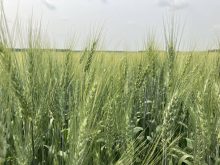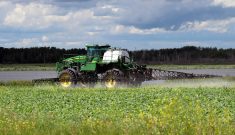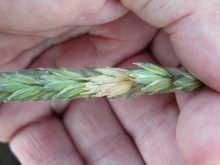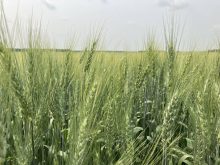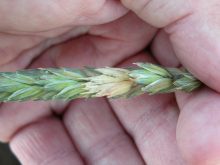Fusarium head blight (FHB) is one of the most destructive wheat diseases in Western Canada, affecting the yield, grade and end-use quality of infected crops. Fungicides can be very effective in preventing FHB outbreaks, as long as they’re applied on time and sprayed the right way. Tom Wolf, a sprayer expert and scientist at Agrimetrix Research and Training based in Saskatoon, offers these pointers for helping you make the most out of your FHB spray.
As for any fungicide application, timing is critical for controlling FHB in wheat.
“There’s only a certain time in the flowering of the wheat plant in which fusarium can be effectively controlled,” says Wolf. “If flowering is over, pathologists say there’s absolutely no point spraying against fusarium anymore.”
Depending on the weather, the window for spraying for FHB may only be a few days long, “so you have to be able to apply the protective spray during a very tight opportunity,” he adds.
With such a tight window, the sprayer needs to be ready to go, with the right nozzles installed and calibrated and the boom set at the correct height. Wolf points out producers must know what weather conditions to look for so they can make the right call on whether to spray or not, adding agronomists can help scout and make recommendations for fungicide timing.
One of the principles of fungicide application is knowing where you want the spray to go so you can make the necessary adjustments. In the case of FHB, the target is always the head of the wheat plant.
“The disease is at the head. It is not anywhere else,” says Wolf. He adds none of the fungicides registered for the suppression of FHB are systemic, which means sprays must be directed at the exposed vertical part of the plant canopy to achieve optimal protection.

For this reason, Wolf recommends using double nozzles with a twin assembly that angles the spray in forward and backward directions, as they’ve been shown to provide more complete coverage of the wheat head.
According to Wolf, separating the forward- and backward-facing fans on the sprayer as much as is practically possible will also help ensure the spray is landing where you want it on the wheat head.
The asymmetric types of double nozzles have proven to be effective for FHB control and are growing more popular with fungicide applicators, Wolf notes.
“The designers of this nozzle recognized that the forward angle doesn’t have to be as aggressive as the rearward angle to have the desired outcome,” he says. “Because you’re moving the boom forward toward the wheat head, the droplets already have forward momentum from that motion and so you don’t have to angle the spray that much to gain the additional advantage.”
Wolf says while finer sprays can help with fungicide coverage, a coarser spray that produces large droplets is better for FHB control. He explains bigger droplets have more momentum and stay true to their direction longer, so they have a greater chance of hitting their intended target.
A possible downside with coarser sprays is there’s a limit to how coarse you can go before you lose coverage. Wolf says producers should keep that in mind when adjusting nozzles, but he points out one option is to increase spray pressure by adding a bit more water.
“If you go to a coarser spray, you do have fewer droplets, and so compensating for that with a higher water volume would be a good idea,” he says, adding this also enables the spray to penetrate a little deeper into the canopy for added protection against other fungal diseases.
According to Wolf, selecting a water volume that’s a little higher than the recommended minimum on the fungicide label will always provide “slightly better coverage, slightly better uniformity, slightly better canopy penetration. Water is just simply the most powerful tool that we have to make things a little bit better.”
Having the right spray quality and boom height are both important considerations when using double nozzles. If the boom is too high, the initial forward and backward angles of the spray as it leaves the nozzle will be lost and the droplets will drop and fall where wind and gravity take them.
Wolf says by using a coarser spray and making sure the boom is low enough, this should retain the angle of attack long enough to ensure the fungicide is deposited where you want it. That’s because the lower the boom, the closer it is to the target and the less time there is to displace the droplets.
“You really should do everything you can to have a low boom height,” says Wolf. “In our research, every time we took a step lower, it had a benefit in terms of hitting the target. We just simply got more and more on the wheat head the lower we went.”
A common boom height for a self-propelled suspended boom sprayer is between 25 to 30 inches above the target. “We’d like to see them lower than that. We’d like to see them less than 25 inches, if possible,” Wolf says.
He acknowledges there’s a practical limit to how low you can go without brushing the canopy, but Wolf is encouraged by automatic height controllers on some newer booms that make it easier to hit the mark.






